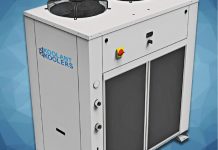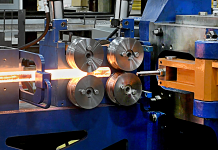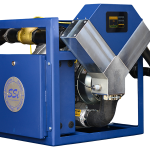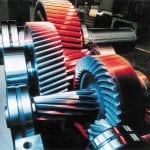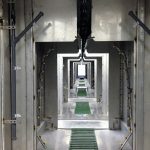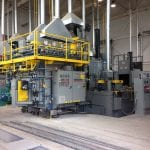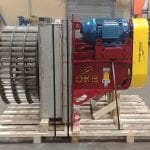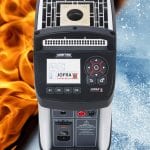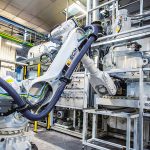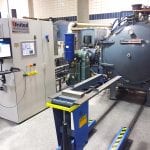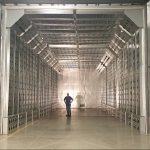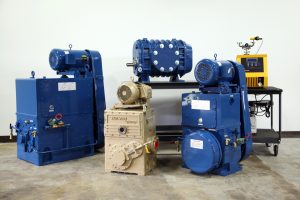Powder metallurgy can be an important part of the thermal-processing world, so it’s important that companies who offer this process, as well as companies who need it, can come together in one place to share and discover the latest innovations the powder metallurgy world has to offer.
For years now, the Metal Powders Industries Federation (MPIF) has sponsored PowderMet, the leading technical conference on powder metallurgy and particulate materials in the America.
PowderMet2024 is a hub for technology transfer for professionals from every part of the industry, including buyers and specifiers of metal powders, tooling and compacting presses, sintering furnaces, furnace belts, powder handling and blending equipment, quality-control and automation equipment, particle-size and powder-characterization equipment, consulting and research services, and much more.
This year’s trade show is in Pittsburgh, Pennsylvania — the Steel City — at the David L. Lawrence Convention Center, June 16-19.
PowderMet2024 is home to the largest annual exhibit in the Americas showcasing the leading suppliers of powder metallurgy, particulate materials, metal injection molding, and metal additive manufacturing processing equipment, powders, and products. This massive display of PM innovations is a must-see opportunity to review the latest technology.
In addition to PowderMet, the event will be co-located with AMPM2024, additive manufacturing with powder metallurgy.
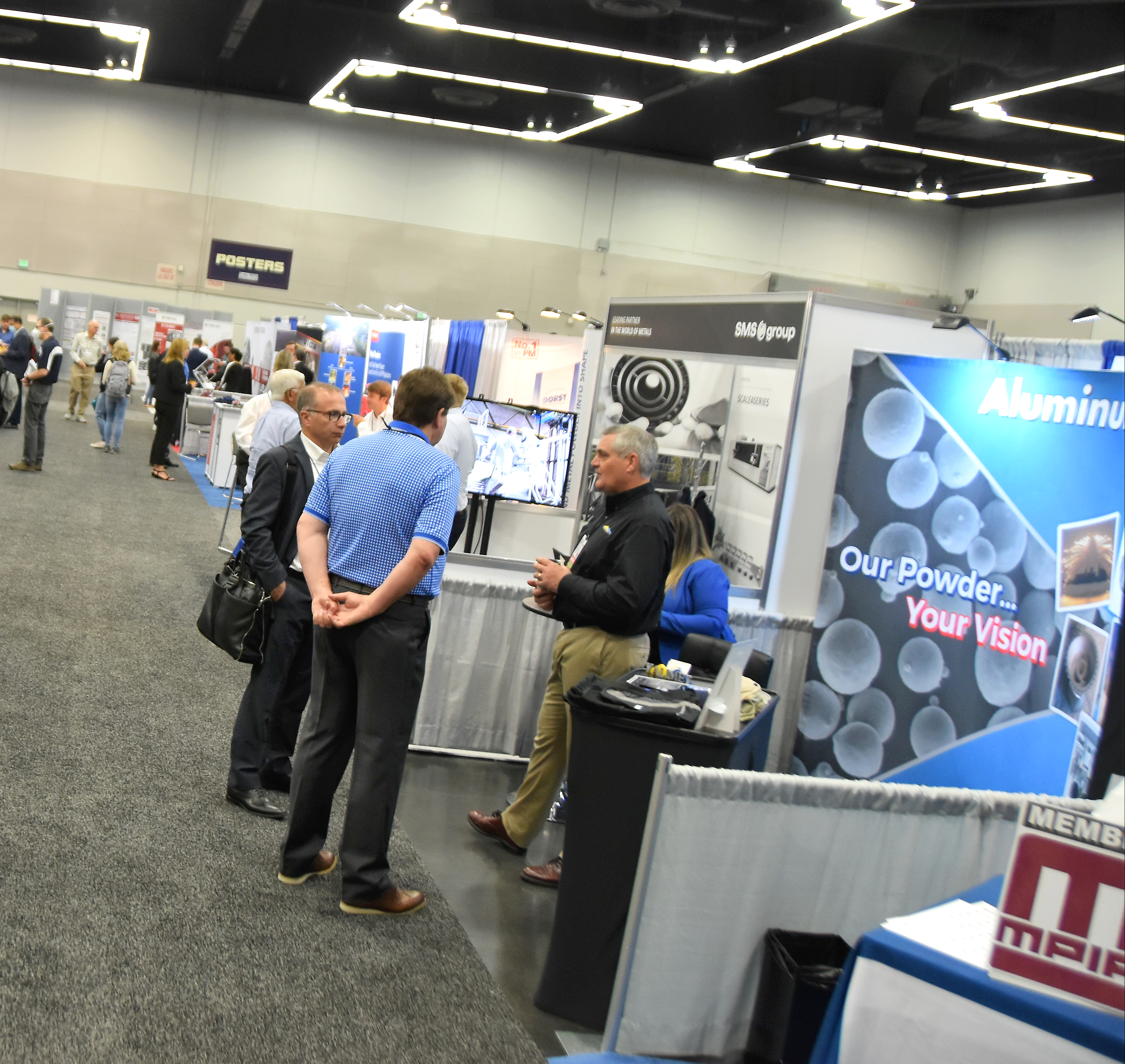
Along with multiple exhibits, attendees will also have access to more than 200 technical presentations from experts from all over the world on the latest research and development.
The conference will open with welcome remarks from MPIF Executive Director/CEO James P. Adams. MPIF President Mike Stucky will share the State of the Industry report as well.
PowderMet2024 will offer a variety of networking opportunities along with carefully planned technical programs that will allow attendees to explore the exhibit hall, catch up on the latest R&D, and celebrate industry achievements.
Some of the technical programs that may be of interest to industrial heat treaters include (check the PowderMet2024 app for times):
Effect of Chemistry and Processing on Sinter-Hardening Performance of Non-standardized Alloy Compositions
MPIF Standard 35 Grade FL-4800 base iron is an adaptable sinter-hardenable base iron, which can provide a fully martensitic structure on large cross section parts. This base material is used in a number of pre-alloyed and sinter-hardenable grades, but does not report a higher graphite composition without the addition of copper. This work will explore using this base iron in a number of compositions outside of the typical standard. Mechanical properties on test bars and parts are explored.
Mechanical and Dynamic Properties of Sustainable Powder Metallurgy Alloy FL-5008
Sustainability is a growing trend within society and the automotive industry. Powder metallurgy (PM) is already recognized as a green technology that can address the sustainability requirements of current and future applications. A recently introduced lean chromium alloy was shown to provide similar mechanical performance to copper steel materials. This alloy also has a sustainability advantage over copper steels. For many applications, fatigue strength is a limiting factor and reliable fatigue data and models are important in selecting the best material system. In this paper, the mechanical properties of the recently standardized material FL-5008 will be presented. Additionally, fatigue data for the FL-5008 will be compared to copper steels and a fracture mechanics model will be presented to reliably predict the effect of density and stress concentrations on fatigue life.
A Melt-Less Method for Making Spherical Ti Alloy Powder
Additive manufacturing (AM) is considered an energy-efficient alternative to conventional subtractive manufacturing of metals. However, the high embodied energy of the feed materials undermines the merits of energy saving in AM. Spherical Ti-6Al-4V alloy powder, widely used in AM, is commercially produced by atomizing Ti alloys made from the Kroll process. This production route incurs high energy consumption due to the low yield, the energy-intensive processes of melting and atomizing the metal into fine particles, and the production of the primary titanium metal. This paper presents a melt-less pathway, called the GSD method, for fabricating spherical Ti-6Al-4V alloy powder from low-cost feedstocks including alloy scrap or oxides. The chemical and physical properties of the fabricated powders are evaluated for AM applications. Energy consumption analysis suggests the process has the potential to significantly reduce the energy consumption of producing titanium alloy feedstock and improve the environmental impact of AM.
C18000 for Sinter-Based Additive Manufacturing
Pure copper has been receiving increased attention and development efforts within the AM community due to its high electrical and thermal conductivity. As the industry evolves, we will need to expand beyond pure copper to meet other application needs. C18000 is a precipitation hardened copper alloy that maintains a reasonable amount of electrical conductivity, but achieves much higher strengths and hardness than pure copper. Here we review results of C18000 printed on a sinter-based AM technology that achieves high density, strength, and conductivity.
Vacuum Sintering of High-Performance Pre-Alloyed Steel
Vacuum sintering is a proven sintering method to improve mechanical properties while eliminating oxidation potential and atmosphere contamination in PM components. Recent progress in vacuum sintering technologies have made this sintering method an attractive manufacturing process for PM materials aiming for property improvement and for the versatility and flexibility to control process parameters. Vacuum sintering furnaces are available in both batch and continuous configurations, with most furnaces using the batch configuration. However, interest in continuous vacuum furnaces continues to grow due to increased production requirements and the advantages over batch vacuum furnaces for processing of larger production quantities. Currently, systematic studies are lacking to compare the vacuum sintering processes with conventional sinter methods for PM steels. In this paper, the sintering responses of a chromium-based, sinter hardenable, pre-alloyed steel were examined in a vacuum.
Smart Solutions to Improve Sintering Atmosphere and Process
The powder metallurgy industry is increasingly adopting Industry 4.0 technologies and solutions to improve production processes and product quality. Proper specification, measurement, and control of furnace atmospheres are always critical to achieving the desired metallurgical and mechanical properties. The combination of atmosphere measurements and other furnace operating parameters (e.g., furnace temperature and pressure) can provide a better view of the whole production. Thermodynamic calculations and field experiences can be integrated into the smart solution to provide process engineers more capabilities to manage and optimize production. In this article, our recent research and development work on smart solutions for the powder metallurgy industry will be presented and discussed.
Processing of High Entropy Al1.8-Cr-Cu-Fe-Ni2 via Powder Metallurgy
High-entropy alloys (HEAs) are presently of great research interest in materials science and engineering. HEAs typically contain at least five elements with equimolar or near equimolar, normally 5 to 35 percent concentrations. HEAs differ from traditional alloys because of high-entropy effects, lattice distortion effects, kinetic delayed diffusion effects, and “cocktail” effects. HEAs have the potential to be used in many applications such as high temperature materials, cryogenic materials, etc. The method traditionally used on industrial scales for preparing HEAs is the vacuum melting method. However, the development of HEAs has been hindered by microstructure defects caused by vacuum melting such as shrinkage cavity, shrinkage porosity, and segregation. This is the motivation for this study to investigate the prospect of using powder metallurgy for preparing HEAs. The results on the influence of the process parameters, e.g., sintering time, temperature, and atmosphere on the microstructure and mechanical properties of the final product will be presented.
Additive Manufacturing Enabled Transition Joints Between Austenitic and Ferritic Steels
The difference in coefficient of thermal expansion (CTE) prevents joining of austenitic and ferritic alloys used in power plants. Further, the difference in carbon chemical potential results in premature service failure of these joints. We use blown powder additive manufacturing combined with thermo-kinetic calculations to design a transition joint between stainless steel 347H and grade 91 steel to reduce the CTE mismatch and obtain a shallower carbon chemical potential gradient. Our characterization showed that, while the composition change was gradual, the phase change was abrupt, possibly because of the dilution during additive manufacturing. Despite the abrupt phase change, we did not observe cracking at the interphase boundaries, but the dual phase austenitic-ferritic region served as a the failure point during tensile testing. We also subjected the samples to long-term aging to determine the phase stability upon elevated temperature exposure.
Influence of Particle Size Variations and Nanoparticle Coating on Flow Behavior of 316L Stainless Steel Powder and Mechanical Properties in Powder-Based Additive Manufacturing
In powder-bed-based additive manufacturing (AM) processes, the flowability of the powder is decisive for the quality of the manufactured part. Since fine particle fractions worsen the flowability, in the laser powder bed fusion (LPBF) process, the lower limit of the powder fraction is usually 15 µm. Nanoparticle coatings can reduce the cohesive forces between particles. It has been investigated how the fumed silica (SiO2) nanoparticle coating affects the initial flow behavior of standard gas-atomized (15-45 µm) 316L powder and powders with modified particle size distribution (0-45 µm, 15-63 µm, 0-63 µm). It was demonstrated that flowability and bulk density increased as a result of the coating. Relative density and mechanical properties of the LPBF specimen showed similar results compared to the uncoated powder with increased tensile strength. The economic potential of coated powder for AM was demonstrated by the successful LPBF processing of fractions 15-45 µm and 0-63 µm.
Materials Extrusion Additive Manufacturing (MEX-AM) of Copper Infill Structures for Accelerated Part Production
Material extrusion (MX) additive manufacturing (AM) combines fused filament fabrication (FFF) and sintering processes to create intricate metallic or ceramic structures using powder-filled polymer filaments. While MX-AM offers design freedom, it faces challenges such as differential debinding in complex parts, leading to cracking and failure. This study explores design and process strategies to mitigate these issues. Copper-filled filaments with 61 vol.% solids were used to 3D print lattice-based infill structures. Samples underwent direct sintering or debinding followed by sintering and were characterized for physical and mechanical properties. Results shed light on density, shrinkage, and mechanical properties for different infill densities (25 percent, 50 percent, 75 percent) using both sintering methods. Findings provide valuable insights for future research and industry, offering innovative strategies for 3D printing complex parts while addressing associated defects and challenges.
Understanding Carbon Footprint and Costs of Atmosphere and Vacuum Thermal Processing
With a growing awareness of the environmental impact of thermal processing, environmental considerations are becoming more critical in operations and facilities planning. While financial planning information is often readily available, it can be difficult for heat treaters to compare equipment from a standpoint of environmental impact. This is due in part to the complex and nuanced differences in equipment design and operation with emissions occurring both on and off-site. In this presentation, a case study comparing a gas-fired atmosphere IQ and an electric batch vacuum furnace will be shared. We will review the technical specifications for each piece of equipment and compare utility and energy consumption, operating cost, and CO2 emissions. We will also highlight the impact of several design variables to consider when specifying and operating equipment. Although the case study is specific, many of the takeaways are generally applicable and can provide insights into how different approaches to heat treat processing can impact operations and the environment.
Reduce Friction with a Secondary Mechanical/Chemical Surface Treatment Process
In this presentation, we will review a new mechano/chemical surface treatment process that greatly improves the frictional characteristics of intermeshing metallic surfaces. This novel process combines controlled contact between the surface-to-be-treated and carrier materials with the addition of bespoke formulations of chemistry to achieve an improved operational interface, both mechanically and tribologically. The chemistries are specially formulated to chemically react and diffuse into the part surface creating an anti-friction/anti-wear nano layer while simultaneously improving surface topography. This results in surfaces with improved frictional coefficients and greater operational efficiencies that result from a reduction in heat and improved wear life.
Hot Isostatic Pressing Optimization of Additive and Micro-Additive Manufactured 316L Stainless Steel via Metal Binder Jetting and Metal Material Jetting
Hot isostatic pressing (HIP) is a post-process heat treatment used primarily to improve density, often required for metal additive manufacturing (AM) components in engineering industries, such as aerospace, automotive, and medical. Since its invention in the 1950s, newer HIP equipment has incorporated rapid cooling or quenching, allowing for better microstructural control. To date, a large deal of literature exists for HIP of laser-based AM, but few for sinter-based AM (SBAM). SBAM continues to grow in popularity due to its capability for large scale production and more accessible range of printable material systems. With this in mind, there exists a need to better understand the effects of HIP on their microstructures and mechanical properties. A matrix consisting of altering temperatures (1,000, 1,150, and 1,250°C) and pressures (100, 140, and 207 MPa) was designed for HIP of 316L stainless steel components with the incorporation of rapid cooling. Components were printed via metal binder jetting and metal material jetting for a comparative study between existing AM and micro-AM (metal material jetting — i.e., nanoparticle jetting) processes in their as-sintered and HIP’d conditions. Scanning electron and scanning transmission electron microscopy were implemented to characterize and quantify the resulting microstructures following each processing condition, including existing phases, defects or inclusions, and their morphologies. Bulk density was measured to determine the effectiveness of HIP parameters, while tensile properties and microhardness were measured to determine their mechanical performance.
Advanced HIP Solutions — Expanding Possibilities for AM Applications
The AM community has accepted hot isostatic pressing (HIP) as a key quality assurance tool, much in the way the casting industry did decades ago. HIP’s ability to eliminate internal porosity is essential for critical applications given the phenomenon of shrinkage as alloys solidify and the fact resultant pores degrade mechanical, corrosion, and sealing properties. There is a practical balance to be found in both the foundry and AM industries where adding HIP as a secondary operation allows for more cost and time savings vs. trying to design and test for net-zero shrinkage. Advances in the science of HIP are uncovering new options to lower costs and optimize processing parameters for AM. However, the use of HIP has expanded well beyond porosity elimination into the areas of powder metallurgy (PM) near-net shape (NNS) design and production of massive components, diffusion bonding for high-temperature applications, and HIP cladding of premium materials (typically corrosion and/or wear resistant) onto selective areas of need only. All highlight HIP’s ability to bond powder-to-powder, powder-to-solid, and solid-to-solid dissimilar materials. As the design of engineered materials continually advances and the demand for higher sustained operating temperatures increases in aero and orbital space flight and nuclear energy, HIP offers another vital tool to achieve these goals.
Develop Low Binder Tungsten Carbide Grades Using Binder Jetting
Cemented tungsten carbides are the most widely used materials in the metal-cutting industry and wear-resistant applications because of the high hardness and wear resistance. Carbides made by beam-based additive manufacturing have low quality due to large pores, inhomogeneous microstructures, and cracks. Binder jetting can produce carbides with microstructure and properties similar to those made by traditional powder metallurgy processes. Previous work has demonstrated the success of printing cemented carbides with high metallic binders. However, it is more challenging to print carbides that are comparable to conventional materials when the metallic binders are below 15 wt.%. This work focuses on the development of cemented tungsten carbides with 10-17 wt.% of metallic binders using binder jetting. The relationship between powder, printing, and sintering to produce commercial quality carbides will be discussed. In addition, applications enabled by using DFAM principles will be presented.
Mechanical Behavior of Reactive Laser Powder Bed Fused of Borated Aluminum Alloy 6061
This study focuses on determining the impact of finely-dispersed boron on the structural mechanical behavior of additively manufactured aluminum alloy 6061 (AA-6061). Reactive additive manufacturing (RAM) through laser powder bed fusion (L-PBF) is employed to overcome the hot cracking challenges associated with AM of AA-6061 by introducing ceramic elements for enhanced manufacturability and grain refinement. Small cubes were made via RAM/L-PBF followed by their electrical discharge machining (EDM) to harvest both vertically- and diagonally-oriented miniature (approx. 20 mm total length) tensile specimens from them. These specimens, together with wrought AA-6061, were tested for tensile strength using a micro-tensile testing system. Results from testing miniature tensile specimens and ASTM standardized tensile specimens of the wrought AA-6061 are presented to help support ongoing certification efforts of this material in the nuclear industry. The tensile behavior between the RAM/L-PBF and wrought AA-6061 are presented and their implications discussed. The RAM powder technology will also be a focus of the presentation.
MORE INFO www.mpif.org/Events/PowderMet2024/FinalPowderMetHomePage.aspx











